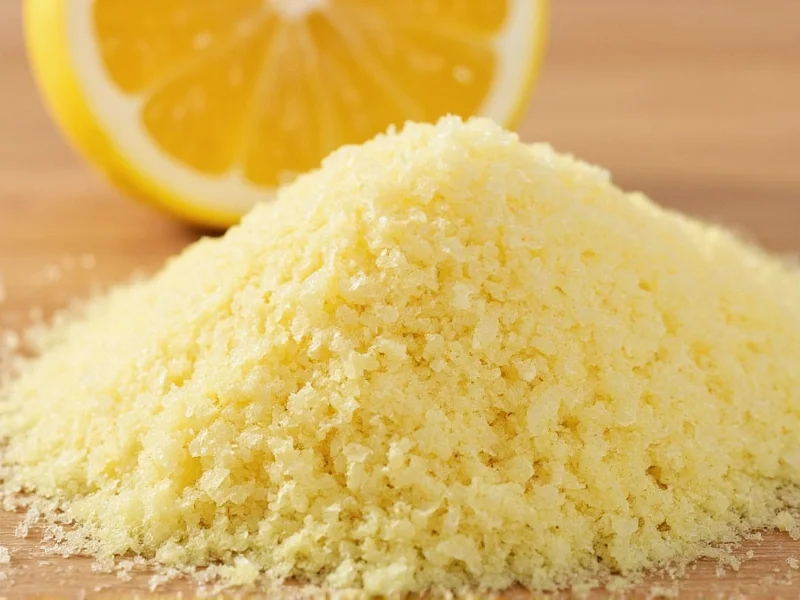When you run out of citric acid or need an alternative for dietary reasons, knowing reliable substitutes becomes essential. Citric acid, a weak organic acid found naturally in citrus fruits, serves multiple purposes in cooking, canning, cleaning, and skincare. Understanding proper replacements ensures your recipes maintain proper acidity levels while delivering expected results.
Why Substitute Citric Acid?
Citric acid appears in many household applications, but several factors might prompt you to seek alternatives. You might have run out unexpectedly, need a more accessible ingredient, have dietary restrictions, or simply prefer natural alternatives to processed ingredients. Some people experience sensitivities to commercially produced citric acid, which is often derived from mold fermentation rather than citrus fruits.
Top Citric Acid Substitutes and Their Applications
Not all substitutes work equally well for every purpose. The right choice depends on whether you're using it for canning, cooking, cleaning, or other applications. Here's a detailed comparison of the most effective alternatives:
| Substitute | Best For | Substitution Ratio | Notes |
|---|---|---|---|
| Lemon juice (fresh) | Canning, cooking, beverages | 1/4 cup = 1 tbsp citric acid | Adds citrus flavor; may alter color in some recipes |
| Lime juice (fresh) | Cooking, beverages, ceviche | 1/4 cup = 1 tbsp citric acid | Stronger flavor than lemon; use in Latin/Caribbean dishes |
| Cream of tartar (tartaric acid) | Baking, candy making | 1/2 tsp = 1/4 tsp citric acid | Less acidic; works well in meringues and frostings |
| White vinegar | Cleaning, pickling | 1/4 cup = 2 tbsp citric acid | Strong flavor; not ideal for sweet recipes |
| Ascorbic acid (vitamin C) | Canning, preventing browning | 1/2 tsp = 1 tbsp citric acid | No flavor impact; excellent for fruit preservation |
| Yogurt or buttermilk | Baking, marinades | 1/2 cup = 1 tbsp citric acid | Adds moisture; changes texture in some recipes |
Canning and Food Preservation Substitutes
When preserving food through canning, maintaining proper acidity is critical for safety. The USDA recommends specific acid levels to prevent botulism. For natural substitutes for citric acid in canning, fresh lemon juice remains the most reliable option. Use 1/4 cup of bottled lemon juice per quart of canned tomatoes as equivalent to 1 tablespoon of citric acid.
For those seeking citric acid alternatives for canning without citrus flavor, ascorbic acid (vitamin C) works well without altering taste. Dissolve 1/2 teaspoon of ascorbic acid crystals in 1 cup of water, then use 2 tablespoons of this solution per quart of canned goods. This maintains safety while preventing discoloration in fruits like apples and pears.
Cooking and Recipe Substitutions
In culinary applications, the best citric acid substitute for cooking depends on the dish. For sauces, dressings, and beverages, fresh citrus juices provide both acidity and complementary flavors. When making homemade gummy candies or sour candies, cream of tartar offers similar textural properties without overwhelming citrus notes.
For delicate recipes where flavor neutrality matters, consider using a combination of vinegar and a small amount of lemon zest. This approach delivers the necessary acidity while minimizing flavor interference. Remember that lemon juice instead of citric acid will add liquid to your recipe, so you may need to reduce other liquids accordingly.
Cleaning Solution Alternatives
When searching for citric acid replacement in cleaning solutions, white vinegar proves exceptionally effective. Create a descaling solution by mixing equal parts white vinegar and water. For tougher limescale on kettles or coffee makers, use undiluted vinegar and let it sit for 30 minutes before rinsing thoroughly.
Vinegar works as an excellent citric acid substitute for cleaning because both are weak acids that dissolve mineral deposits. However, vinegar has a stronger odor that dissipates as it dries. For a more pleasant scent, add citrus peels to your vinegar solution while it soaks.
Special Considerations for Different Applications
Understanding when to use specific substitutes prevents recipe failures. In cheese making, citric acid helps achieve proper curd formation. For this specialized application, lemon juice serves as the most reliable substitute, though it may impart a slight citrus flavor to fresh cheeses like mozzarella.
For skincare formulations requiring pH adjustment, ascorbic acid provides similar benefits without potential irritation from stronger acids. When making bath bombs, cream of tartar works well as a tartaric acid vs citric acid substitute, though you'll need to use approximately twice as much to achieve the same fizzing reaction.
When Not to Substitute Citric Acid
Certain applications require precise citric acid measurements that shouldn't be substituted. In molecular gastronomy techniques like spherification, citric acid's specific molecular structure creates the desired reaction with sodium alginate. Substituting other acids may prevent the technique from working properly.
For medical applications or when treating specific health conditions, consult a healthcare professional before substituting citric acid. Some people use citric acid for kidney stone prevention, and improper substitution could affect treatment efficacy.











 浙公网安备
33010002000092号
浙公网安备
33010002000092号 浙B2-20120091-4
浙B2-20120091-4